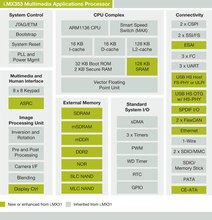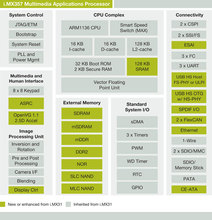Freescale re-purposes automotive chips
Mar 3, 2009 — by LinuxDevices Staff — from the LinuxDevices Archive — 7 viewsFreescale is sampling a pair of new ARM11-based system-on-chip processors (SoCs) targeting industrial and consumer devices running Linux and other embedded OSes. The i.MX353 and i.MX357 omit the MLB (media local bus) and automotive focus of other i.MX35 parts, and with $12 pricing in volume, target a broader customer base.
The new i.MX353 and i.MX357 parts belong to an i.MX35 family that launched about a year ago. The earlier i.MX35 parts all targeted automotive applications, and were featured in the “automotive” track at last year's global Freescale Technology Forum (FTF) events. They include the i.MX351, i.MX355, and i.MX356.
 i.MX31 PDK (Click for details) |
Now, with Intel's Automotive Atom parts arguably stealing the spotlight for now, Freescale is looking to branch i.MX35 into new markets. Its more general-purpose parts are sampling today, with volume production expected in Q2. A separate PDK (probably similar to the cool-looking i.MX31 PDK) is expected to arrive in May.
ARMed for action
Like the older i.MX35 parts, the new models belong to Freescale's i.MX3x line, which debuted in Jun. of 2005. The i.MX3x parts all use ARM 1136JF-S cores, and integrate a flexible mix of co-processors (such as image processing units and multimedia engines) that connect via a crossbar switch.
The new i.MX353 and i.MX357 shave cost by omitting the MLB (media local bus) found in earlier i.MX35 parts. Specific touted applications include HMIs (human-machine interfaces) for factory automation, building control, home displays, and medical devices.


i.MX353 (l) and i.MX357 (r) diagrams
(Click either to enlarge)
The higher-end i.MX357 part mixes in OpenVG 1.1 acceleration, enabling it to additionally target the hot PND market (portable navigation devices), as well as e-books and other battery-powered consumer devices with graphical user displays. Freescale claims the OpenVG engine can “convert” Flash animations to native C code, for snappier rendering of both vector and raster graphics.
What's inside?
The new i.MX35 parts both use a 532MHz ARM1136JF-S cores, and integrate LCD controllers, GPUs, and vector FPUs (floating point unit). They use a multi-level cache with 16KB each of instruction and data cache, and 128KB of on-chip L2 cache. The chips interface with lots of memory types. On-chip peripheral interfaces include 10/100 Ethernet, CAN, and USB+PHY, among others (see spec list below for full list).
Freescale lists specs for the new i.MX353 and i.MX357 as follows:
- Processor: ARM1136JF-S at 532MHz
- Cache: 16K I/D L1, 128KB L2
- Memory: interfaces to SDRAM, Mobile DDR and DDR2, SLC and MLC NAND flash, NOR flash and SRAM
- Graphics:
- LCD Controller
- OpenVG 1.1 GPU (i.MX357 only)
- Storage: PATA/CEATA interface
- I/O:
- 1 x 10/100 Ethernet
- 2 x CAN
- USB:
- 480Mbps OTG (“on the go”)
- 480Mbps host
- 3 x I2C
- 2 x SSI/I2S
- 3 x UART
- 2 x SPI
- Expansion: SD/SDIO/MMC
- Package: 17 x 17 BGA 0.8mm 400 ball
- Operating temp:
- 532MHz: -20 to +70 degC
- 400MHz: -40 to +85 degC
Without citing any source, Freescale says BSPs for Linux and Windows CE are available for its i.MX35 chips, along with “RTOS options.”
Paul Marino, GM of multimedia applications, stated, “As the graphics content of industrial and consumer applications grows increasingly complex and compute-intensive, embedded developers are choosing cost-effective processing solutions that deliver exceptional multimedia capabilities.”
Availability
The i.MX353 and i.MX357 parts are sampling now, with production slated for Q2. Pricing starts at $12 (in 10K quantities). An i.MX35 PDK is expected in May, priced at $1,500.
This article was originally published on LinuxDevices.com and has been donated to the open source community by QuinStreet Inc. Please visit LinuxToday.com for up-to-date news and articles about Linux and open source.